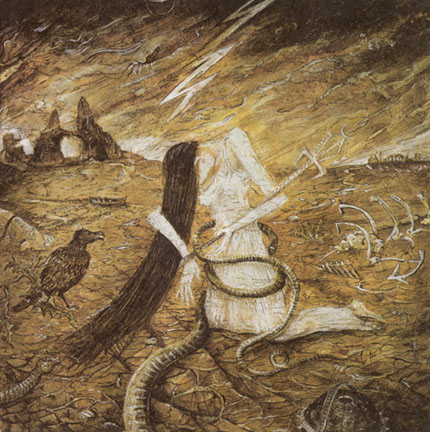Top and Bottom: 150,000 SS troops gathered
Top: The crowd massing at the heels of Glass & the Machines of God, hands outstretched.
Bottom: Children saluting der Führer in the propaganda film Triumph des Willens (Triumph of the Will)
Imagery partially inspired by the Machina track Raindrops and Sunshowers. This is revealed through the particular circumstances of the plate: a lone figure peels back the very fabric of the ocean as though it were a drapery, coming face to face with a reflection in the water:
I send my echo out
To get your love without
Obscured reflections of
My love
Raindrops and SunshowersThe plate takes place during a sunshower. While clouds above loom darkly, the sky itself is bright and vibrant; while much of the forefront is somber and tenebrous, the island and sky are particularly bright.
Most telling of the allusions to Raindrops and Sunshowers is an excerpt of the song itself present in the top left quadrant of the photo:
 "Rain falls on everyone/The same old rain"
"Rain falls on everyone/The same old rain"The lyrics in conjunction with the plate are rather comforting, and ask us to remember our humanity. Everyone on this earth will experience the same elements that make us human: pain and fear, hope and joy, love and despair. When we're most isolated and guarded, it's reassuring to know that we're not alone, that "rain falls on everyone/The same old rain".
While the sunshower carries on, the center figure pulls back the ocean curtains and comes face to face with a three eyed sage, presumably, though not necessarily, Shiva.
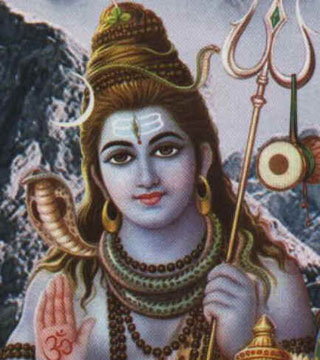 |
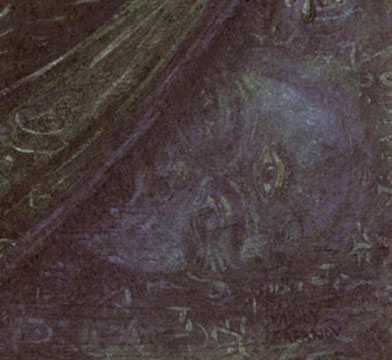 |
|
Left: Shiva, one of five manifestations of the divine and one of the Trimurti (alongside Vishnu and Brahma), personifies transformation and destruction. One of Shiva's characteristic features is his prominent third eye.
Right: Figure in Plate VII, peering back from the water |
The concept of the third eye is known to numerous cultures under many names. While primarily known as the third eye, eye of wisdom, or the inner eye, to students of the chakras, it is recognized as ajna, located between the brows. To the Kabbalists it was readily symbolized with Da'at, the lone location where all ten of the Sephiroth meet as one, and as such, was also represented as the soul under the Tree of Life.
While it is known by many names, the third eye is often associated with similar traits. First and foremost, it is a symbol of enlightenment and illumination, and is often found on depictions of the wisest and most knowledgeable figures: from Shiva and Buddha, to bodhisattvas, sages, yogis, and more.
Apart from enlightenment, other traits attributed to the third eye include gnosis, clairvoyance, intuition, understanding and perception.
A great clue is given in the title of the plate, PEERING DEEP INTO A MIRROR UNTRUE, as it signifies that the individual is not the same as what is seen in their reflection. To further clarify, the individual has not yet awoken, transcended, achieved gnosis or enlightenment. It is apparent that the individual has not yet acquired any wisdom of any sort. To reinforce this concept, the individual has their eyes closed, symbolically blinding them from their true potential staring back at them.
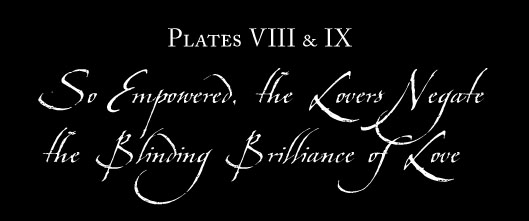
.jpg)
Glass and June in the only diptych picture of the Machina booklet. Glass dons a serpent in the guise of headphones while wielding an athame in his left hand. His androgyny is shown in his feminine intuitive subconscious which appears reversed upon his head; dual faced like the Roman god Janus. His androgyny is even more pronounced by the life which grows inside him. June wields a staff –also in her left hand- blending the properties of sulfur, mercury and sol as she stands before the ruins of wise king Solomon. Not far from the bust of the goodly king lays the philosopher's compass, and to the far left a symbol reminiscent of the globus cruciger. In the background lies a potent tree of wisdom, dubbed 'The Crying Tree of Mercury'.
The diptych is one of the few plates within the Machina booklet which contain lyrics directly taken from one of the songs off of the album. This creates a special relationship between the imagery of the plate and the words of the song to which it relates to.
In this plate, we see an excerpt of 'The Crying Tree of Mercury' directly above and below Glass' left hand:
"[This is] the song I've been singing my whole life
I've been waiting like a knife
To cut open your heat
And bleed my soul to you
I did it all for you
You and you and you and you"
.jpg) The excerpt from "The Crying Tree of Mercury"
The excerpt from "The Crying Tree of Mercury"While the lyrics may suggest a certain form of beautiful sacrifice, the title of the plate ("So empowered, the lovers negate the blinding brilliance of love") suggests that all is not as straightforward as it first may seem. In this regard, we may wish to examine the lyrics in a slightly more sinister context. After all, to negate the blinding brilliance of love is to undo it. I would postulate that the love expressed at this point is still not fully developed and mature. While it holds the seed of true love (one that is both unconditional and selfless), it remains possessive and fixed like an ever watching eye. Glass will eventually find redemption through love (both through June, and through God), but this plate is not that moment in time.
It does not take a leap of faith in order to connect the lyrics which are referenced with the prominent tree in the background of this diptych. This is The Crying Tree of Mercury.
.jpg) The Crying Tree of Mercury
The Crying Tree of MercurySymbolically, if a tree were to cry mercury, then it would be expelling wisdom and gnosis in its tears. This is not an altogether uncommon connection to make; trees and wisdom. Many cultures hold prominent myths surrounding a particular tree of legend: the Norse had the Yggdrasil from which Odin hung himself to acquire wisdom. Christ was allegedly sacrificed upon a cross carved from a tree of wisdom (which holds all sorts of amusing ironies, if you think on it).
On this Crying Tree of Mercury is born at least six prominent fruit:
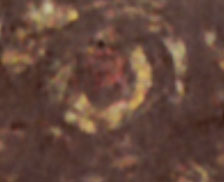 First fruit: An orb with a fiery mercurial center. The circled center pays tribute to Sol, and its sublime perfection.
First fruit: An orb with a fiery mercurial center. The circled center pays tribute to Sol, and its sublime perfection.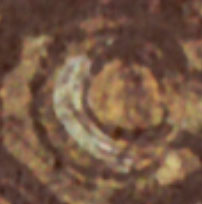 Second fruit: An orb accentuating a crescent moon, which is the symbol of Luna, the other half of the most sublime elements. Nearly nothing on its own, but in conjunction with Sol it is worthy of celestial perfection.
Second fruit: An orb accentuating a crescent moon, which is the symbol of Luna, the other half of the most sublime elements. Nearly nothing on its own, but in conjunction with Sol it is worthy of celestial perfection.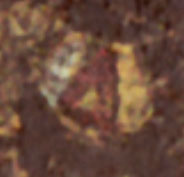 Third fruit: An orb bearing the trinity, represented as a triangle. The trinity is composed of God the Father, God the Son, and God as the Holy Spirit
Third fruit: An orb bearing the trinity, represented as a triangle. The trinity is composed of God the Father, God the Son, and God as the Holy Spirit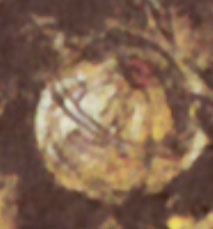 Fourth fruit: An orb with a circumference pattern around it, possibly reinforcing the all encompassing nature of the act -- but this is merely speculation.
Fourth fruit: An orb with a circumference pattern around it, possibly reinforcing the all encompassing nature of the act -- but this is merely speculation. Fifth fruit: A brilliantly shining orb, much like the philosopher's stone, which could only be nurtured by wisdom.
Fifth fruit: A brilliantly shining orb, much like the philosopher's stone, which could only be nurtured by wisdom. Sixth fruit: Perhaps the delusion of a pattern seeking animal, but it appears to be a delightfully vibrant and laughing orb. Whether this remains coincidental or intentional only Kafanov could clarify. If coincidental, it can be passed off as quite amusing. If intentional, this may be a nod to Hermes Trismegistus and his three facets (Mercury/Hermes/Thoth) – all three reputed for being mischievous tricksters with a most sublime wit.
Sixth fruit: Perhaps the delusion of a pattern seeking animal, but it appears to be a delightfully vibrant and laughing orb. Whether this remains coincidental or intentional only Kafanov could clarify. If coincidental, it can be passed off as quite amusing. If intentional, this may be a nod to Hermes Trismegistus and his three facets (Mercury/Hermes/Thoth) – all three reputed for being mischievous tricksters with a most sublime wit.Turning to Glass, we are given several insights into his "androgynous figure" (as described by Billy Corgan in his GATMOG interview). Most noticeable are his dual faces. The dual faced motif is evident in numerous mythologies in a variety of cultures throughout the ages, but perhaps the most prominent figure among the world mythologies is that of the dual-headed Janus of the Roman pantheon.
.jpg) Glass; Janus-faced with a serpent in the guise of a pair of headphones
Glass; Janus-faced with a serpent in the guise of a pair of headphonesJanus served as one of the elder gods amongst the Roman pantheon. His place among them was cemented so well that he was often dubbed the "god of the gods". Janus was primarily invoked in ritual and sacrifice, called upon for all dealings relating to new beginnings (and from which we derive the name "January": first month of the calendar year). Janus was also attributed as a celestial gatekeeper of sorts, and was seen as the guardian of all doorways, passages, and paths.
Often represented as an androgynous figure, Janus received the attention of the alchemists. Janus' union of man/woman, action/thought, and macrocosm/microcosm all served to reiterate one of the most common themes within alchemy, which is the unification and balancing of opposites.
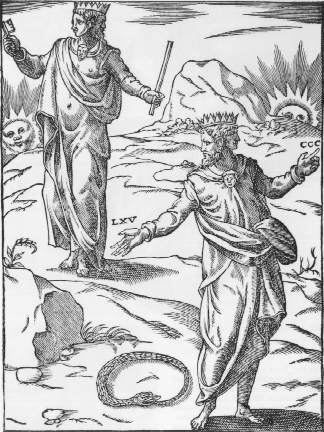 Janus, from Vincenzo Cartari's Le Imagini de gli Dei (1608)
Janus, from Vincenzo Cartari's Le Imagini de gli Dei (1608)To add to the vested alchemical interest, Janus was sometimes described as the joined union of Artemis and Apollo; non-coincidentally the goddess of the moon, and the god of the sun. In this regard, Janus was another depiction of the rebis/hermaphrodite/androgyne.
Sometimes Janus was also shown with four heads and known under another name – Janus Quadrifons. While in this form Janus showed dominion over the four quarters of the earth, the seasons, the temperaments, and the classical elements.
The mystical perspective of Glass' depiction is also of interest. The male portion of Glass is shown with eyes closed, while his feminine and intuitive inverse (representing the psyche and subconscious) is shown fully awakened and aware, like a third eye opening from a long slumber.
The two faces have also been in the collective conscious for quite another reason. The Greeks first popularized the concept of these specific types of masks, based off of their two most common types of plays: comedies and tragedies.
These "comedy/tragedy" masks, primarily worn during the golden age, enabled a single individual to play multiple roles, and helped differentiate between the characters by use of exaggerated features.
Returning to the androgyny of Glass, we may notice that he shows a more pronounced sign of his androgyny. Apart from being Janus-faced, he is quite evidently pregnant.
.jpg) Glass maternally protecting his womb. The blending of masculine and feminine elements is consistently evoked through alchemy, denoting the alchemical androgyne – the perfect union
Glass maternally protecting his womb. The blending of masculine and feminine elements is consistently evoked through alchemy, denoting the alchemical androgyne – the perfect unionWe may now turn our attention to ritual magick, as Glass is shown wielding an athame in his left hand.
.jpg) The athame
The athameThe athame is a ceremonial dagger used for ritual (and occasional practical) purposes. Today it is most visibly recognized in the Wiccan communities, though it has often by used by any practitioners of ritual magick.
The athame is a magickal instrument used to pay reverence to or to invoke the blessings and protection of deities. It is usually (though not always) double bladed, and is sometimes given a pronounced black handle. What is a far more common feature however is that the blade or hilt of the athame often contains –whether engraved upon the blade or in the shape of the blade itself- esoteric shapes or imagery.
The athame in our plate continues the theme of androgyny and union by the dual-joined circles which are in it penetrated straight down the middle by the hilt, demonstrating once again the union of two into one, and the balancing/unification of supposed dichotomies.
It's also worth noting that Glass wields the athame in his left hand, the hand usually associated with magick and ritual.
Continuing on the theme of ritual, we see June wielding a custom staff, standing before a ruined bust of a great and wise king. The staff appears to be a mix of the symbol of sulfur (the main core of the staff, culminating in the triangle/arrowhead), the symbol of mercury (the horns), and Sol (the gold center in between the horns). Mercury and Sulfur are two of the three primary elements of the alchemists' involved in the great work (the other being salt). In this depiction, Mercury and Sulfur work together; the liquid, and volatile nature of Mercury is counterbalanced by the dry and fixed nature of Sulfur. The golden center is channeling the perfection of Sol's golden nature.
.jpg) June wielding her staff
June wielding her staffThe desecrated bust that June stands before is that of one of the most legendary figures of the Old Testament - wise King Solomon. Revered by Jews, Christians, mystics, alchemists and Kabbalists, Solomon is the multifaceted king, equally marked by wisdom as he is wealth, power, an extensive rule and his inevitable fall from grace. For most of these qualities, he became ingrained in the obscure fables, legends, and general lore, and became the pen name of many famous authors, to whom grimoires were attributed to.
Solomon's name derives from the Hebrew name 'Shelomoh', which means "complete" or "peaceful". It is thought that his name may have been bestowed upon him during his coronation.
The First Book of Kings tells of one tale in particular in which Solomon, still a fledgling king, has an encounter with God in which he is offered anything his heart may desire. Solomon makes a humble request and asks for an understanding heart so that he may understand his people, and discern good from evil. For such a selfless request, God tells Solomon that he will be the recipient of wisdom on a level which surpasses any other of his people. He is also promised power, wealth, and all forms of prosperity. It is also revealed in The Second Book of Samuel that God gives Solomon another title, 'Jedidiah', which means "loved by God".
Solomon was blessed with a long and prosperous rule for forty years. Perhaps Solomon's most well known accomplishment in this time was the completion of the building of the First Temple of Jerusalem. While the factuality of the matter is hotly contested, it is described as being completed circa 960 BCE before being razed down by the Babylonians in 586 BCE. The temple served as the center for the Israelites, and it was thought that God himself dwelt within its walls.
But as is common, God's most loved creations tend to fall from grace. In his later years Solomon became a lax pacifist, doing nothing to stop the idolatry of his numerous wives and concubines, and, according to some stories, dabbled in the mastery of devils and spirits which he tried to command with a magic ring. In many of these descriptions they speak of much strife, in which Solomon was tricked by one of the demons he tried to command, robbed of his throne, lost the rule of his people for many years, and fell out of God's favour.
Allegorically, one could see the broken bust of Solomon as the destruction of gnosis, knowledge, virtue, and redemption. The Babylonians, like our society today, shared in its ignorance, aggression, and its ultimate doomed nature. June pays tribute to this once great king, in silent mourning and loss.
.jpg) Broken bust of wise king Solomon, builder of the First Temple of Jerusalem
Broken bust of wise king Solomon, builder of the First Temple of JerusalemIf we move to the bottom right hand corner of the plate, we can see a cement slab. This slab is actually an intricate detailing of "the philosopher's compass", a beautiful piece of imagery which shows the production of the philosopher's stone:
.jpg) |
.jpg) |
Above left: Detail of the "philosopher's compass" producing the "greatest poison and the supreme medicine" (otherwise known as the philosopher's stone).
Above right: The philosopher's compass as depicted by Vasily Kafanov. |
.jpg) 'Der Compaß der Weisen', Ketima Vere, Berlin,1782
'Der Compaß der Weisen', Ketima Vere, Berlin,1782Alexander Roob wrote of it in The Hermetic Museum:
"The 'philosophers' compass' between the magnetic poles of the Work, symbolized here as the two Masonic columns of Solomon's temple. Joachin: male, upper fire (esh) and lower air, Boaz: feminine, upper water (Mayim) and lower earth. These produce the lapis. It joins the powers of the upper (the planets) and the lower. (The materials in the Work: tartar, sulphur, sal ammoniac, vitriol, saltpeter, alum and in the centre antimony, the saturine source material, said to be the greatest poison and the supreme medicine). Its symbol is the imperial orb."
Also worthy of our attention: in the bottom left hand corner of the plate lays a symbol reminiscent of the globus cruciger (meaning 'cross bearing orb'). The cruciger is a common symbol in biblical art, usually wielded by a figure of divine authority, representing the risen Christ who holds dominion over all of the earth.
.jpg) A religious relic reminiscent (but by no means identical to) the globus cruciger
A religious relic reminiscent (but by no means identical to) the globus crucigerLooking to the right of June we can also see two symbols. This first symbol may also be found in plate XI – "The I of the Radio". Once again, it shows the power of four, in much the same way as Janus Quadrifons does.
.jpg) |
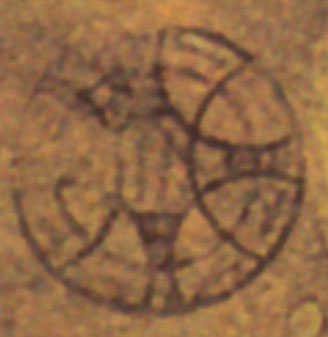 |
Above left: The world, sectioned it quarters, which "shows the possible relationships and transformations of the four elements, both between each other and with respect to the four seasons and the temperaments. Earth – autumn – melancholic/ fire – summer – choleric/ air – spring – sanguine/ water – winter – phlegmatic." – Alexander Roob, Alchemy & Mysticism: The Hermetic Museum
Above right: Kafanov's depiction (rotated 90 degrees, in order to show their identical nature). |
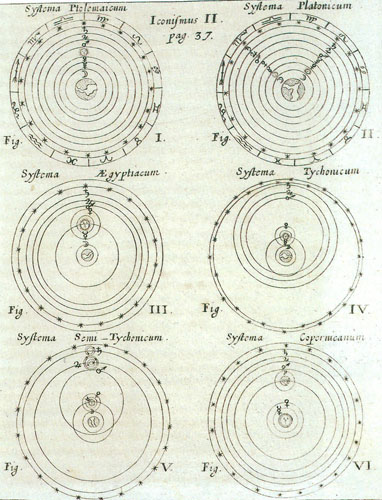 |
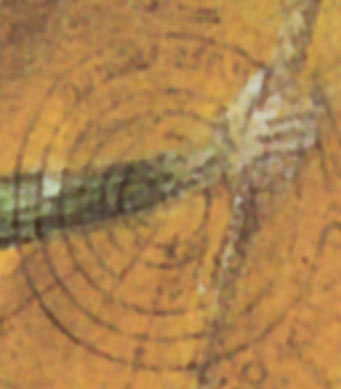 |
Above left: comparative illustrations of possible cosmological orders proposed over the centuries (Ptolemaic, Platonic, Copernican, etc).
Above right: Kafanov's illustration, making many distinct similarities to the cosmological system proposed by Copernicus. The NK is confident we can find an exact comparison image for a future update. |
Another concept worth noting is that the pair of headphones that Glass is wearing is in the guise of a serpent. The serpent, being a symbol of gnosis and the inner light, transmits the voice of God like stereo headphones directly into Glass' head. As the serpent is also a messenger of wisdom, the words he is transmitting reflect a near-divine level of depth and importance.
However, we must also acknowledge another potential meaning (for not all are friends of the serpent).Christianity regards the serpent as synonymous with Satan (despite there being no connections of such made within Genesis). Nonetheless, in this interpretation, the serpent may be seen as a symbol of doubt and temptation. If taken in this context we must be cynical of the "voice of God" which Glass imagines to be genuine (a similar doubt of the voice he hears is also evident in the monologue of "Glass and the Ghost Children")
The idea of God being received through the radio is quite obviously a reference to I of the Mourning, along with the first Glass and the Machines of God web animation, which shows, in detail, Zero hearing the voice of God.
One last thing worth noting. We can see that the serpent/cord travels from Glass, into June's plate and penetrates the philosopher's compass, serving as the divine spark which infuses the compass to produce the philosopher's stone, purest of all substances and capable of transcending the mind, body and spirit into a state of oneness with the universe.
Arguably the 'darkest' of all the plates (and also a personal favourite), it is fitting that the putrid wasteland which encompasses the plate is heavily laden with depictions of Nigredo, the first stage of the alchemical journey towards transcendence, marked by the metaphorical blackening or death of the alchemist.
The scene takes place at the apex of the blackening; nearly everything in the plate, from the scenery, to many of the figures in the forefront, is dying, or highlights a great death or transformational aspect of some sort. Similarly, in the tarot (which Corgan would host portions of the Thoth deck online, circa September 2001 – Novemeber 2002), Death was marked as a card denoting great personal change or transformation.
A woman in white dress drives a ceremonial sword through herself, in an act of self sacrifice. It is worth bringing to light that the manner of her death is slightly reminiscent of seppuku, a ritualistic self sacrifice made famous by the bushido, a code of conduct and "way of the warrior".
Seppuku was an act traditionally carried out to restore honour; deny the enemy the privilege of capture, or to make amends for one's actions. It was typically carried out by driving a ceremonial sword or dagger through the chest, and self eviscerating and disemboweling oneself. While jigai, -- a similar act done by the cutting of the jugular vein -- was more commonly used by women than seppuku, it is not completely unheard of for a woman to commit it. Another reminiscent element of seppuku present in the plate is the fact that the women in question is dressed in white ceremonial robes, as was common with those who were about to commit the act.
Seppuku was an especially painful form of suicide in which the individual was expected to keep their composure, suffering through the act in silence. Some of the most devoted would compose a death poem, written in tanka style, as they waited for death to claim them.
To the left of the woman, a crow (or raven) watches intently. Regardless of whether the bird in question is a crow or a raven, both are attributed to Nigredo, which fits with the largely self destructive, death oriented theme permeating the plate.
As birds could gracefully navigate the skies, the alchemists came to regard birds as symbolic representations of the soul's own journey. Ascending from the world of the material and the transient to the world of the spiritual and the divine, birds represented the soul's innate aspiration to ascend, and to transcend the body. From this concept, bird symbolism flourished, with particular birds denoting various stages of the soul's journey.
In many cultures, crows (and especially ravens), are thought to transport the souls of the dead into the afterlife. Perhaps this is why in the far background we see a luminescent individual rising towards the heavens, onwards to her next life.
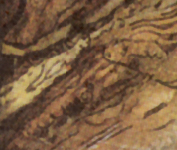 Woman ascending to the sky, top left corner of the plate
Woman ascending to the sky, top left corner of the plateWith death comes transformation, and as such, symbols of Albedo may also be spotted. This transition is marked in the contrast between black and white. Her hair, the crow/raven, the globe in the bottom right hand corner, and much of the atmosphere are black, likening it to Nigredo, while the woman's skin and her sword are a luminescent white, likening it to Albedo. In addition, this transition from Nigredo to Albedo can be seen in the recurring symbolism of exposed bones, to the right of her.
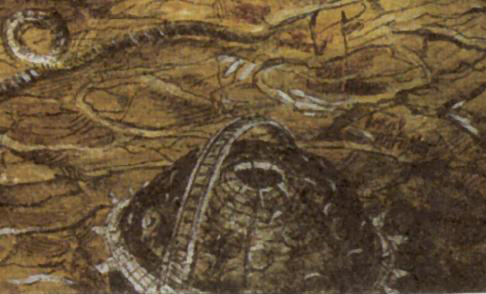 The blackened globe, symbolic of Nigredo and the all encompassing decay and lifelessness reflected in the wasteland.
The blackened globe, symbolic of Nigredo and the all encompassing decay and lifelessness reflected in the wasteland.Another creature is also present. The snake, while coiling around her form, does not seem to be constricting. In addition, its head can be spotted watching her act from the bottom left hand corner. The snake, one of the original creatures to denote wisdom, literally exudes metamorphosis and transformation, shedding its skin and starting anew, on a consistent basis. This renewal parallels the concept of new life made possible through death which is at the thematic forefront of this plate.
The plate also suggests the cyclical nature of life and death through a canoe in the mid-left portion of the plate, hinting at an earlier time in which this wasteland was abundant with life, and flowing water.
Behind the canoe, hidden deep in the background of the anti-Eden of scorched earth, we can witness three individuals. The first, a kneeling figure, is stooped in prayer and receives a blessing from the second figure that presides over them. A third figure, to the right of the blessed figure, is seen holding a scepter high into the sky, calling on the Gods, who respond with a divine bolt of lighting which cracks the sky right open.
 The three figures. Three plays an important role in numerology, the trinity, and numerous other sects, both occult, and in traditional religious mythologies. In this photo, one man prays, while another blesses. The third calls upon the heavens.
The three figures. Three plays an important role in numerology, the trinity, and numerous other sects, both occult, and in traditional religious mythologies. In this photo, one man prays, while another blesses. The third calls upon the heavens.



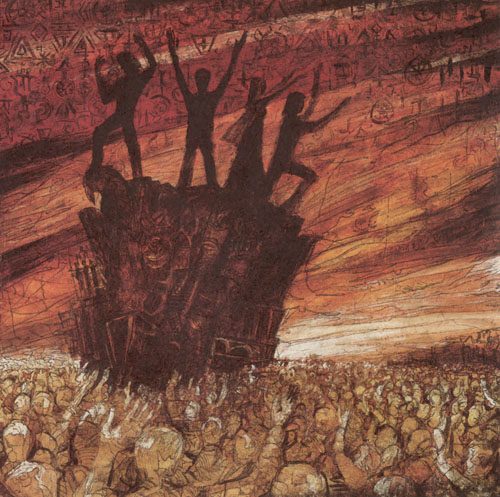
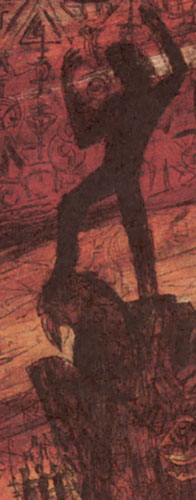
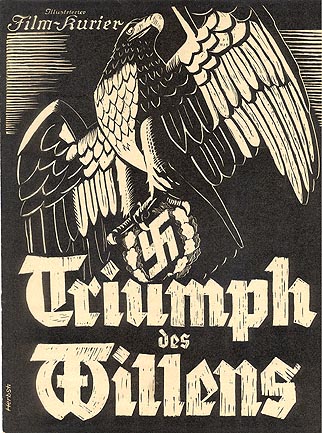





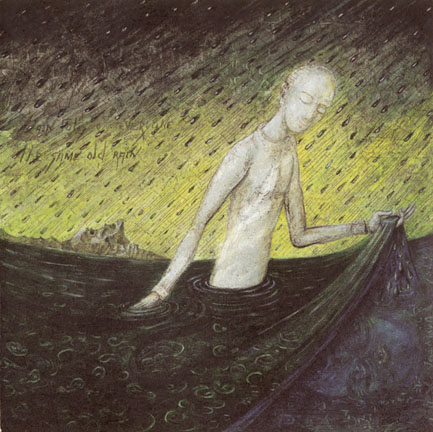




.jpg)
.jpg)
.jpg)






.jpg)

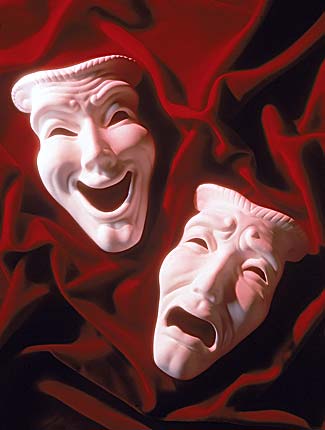
.jpg)
.jpg)
.jpg)
.jpg)
.jpg)
.jpg)
.jpg)
.jpg)
.jpg)




